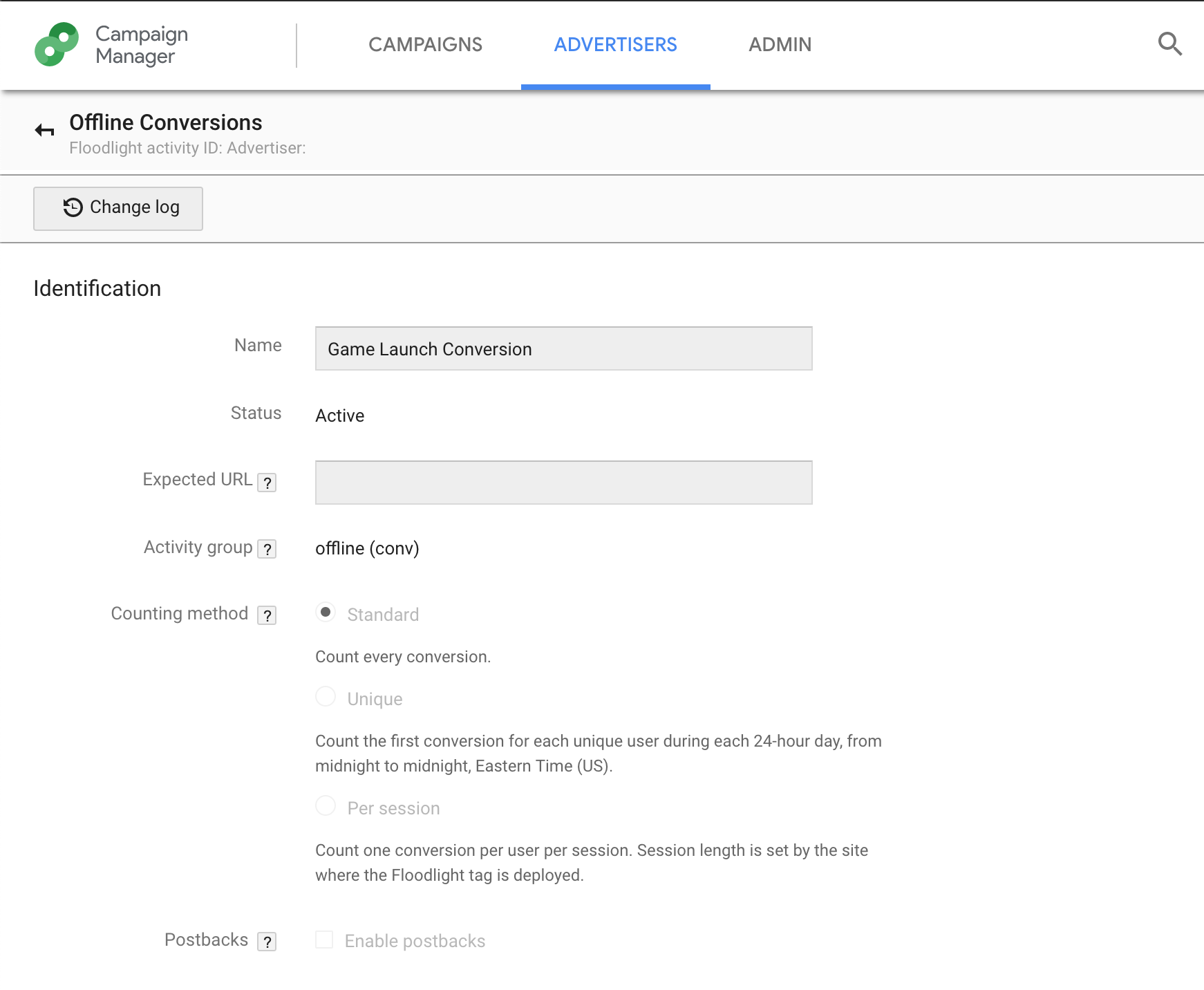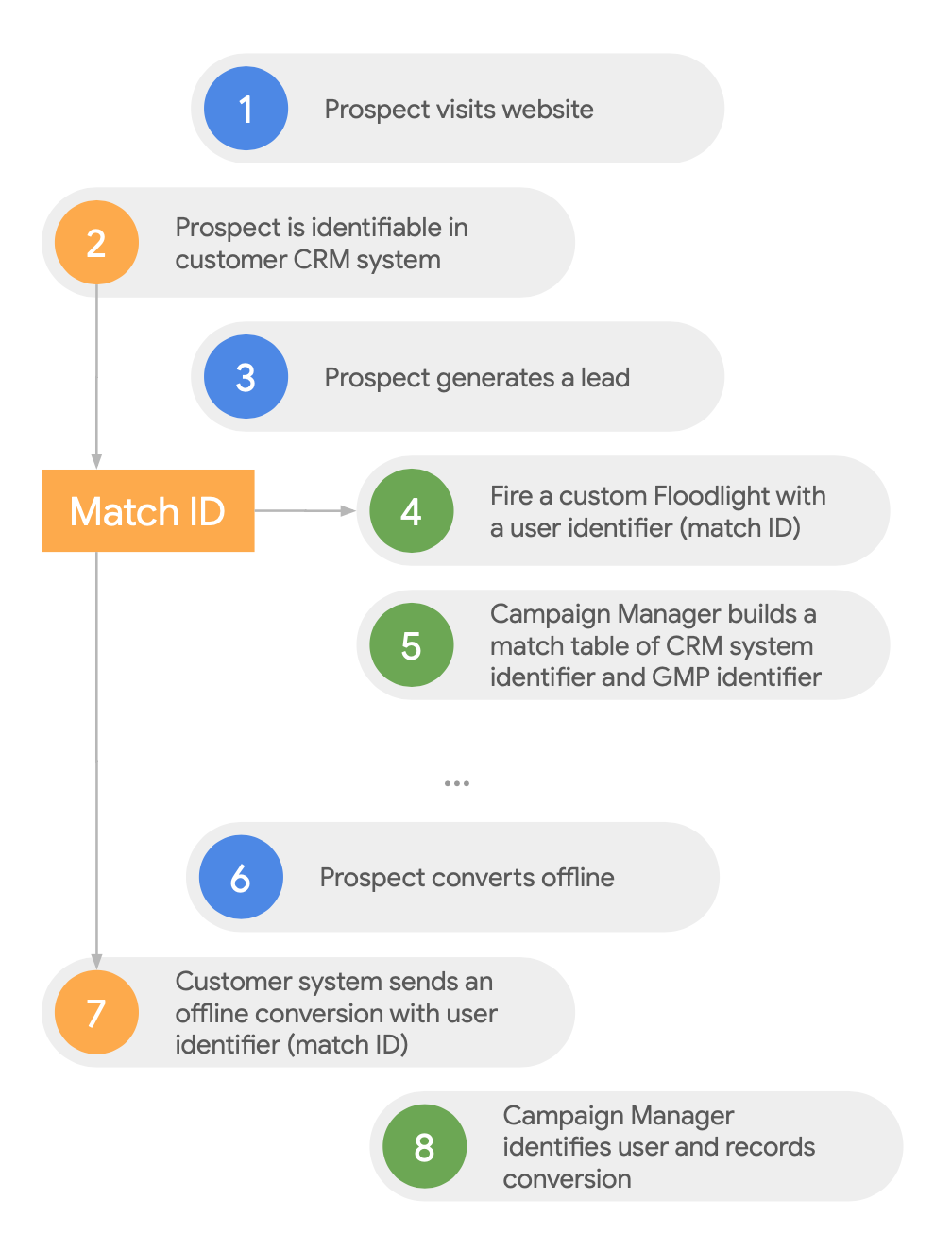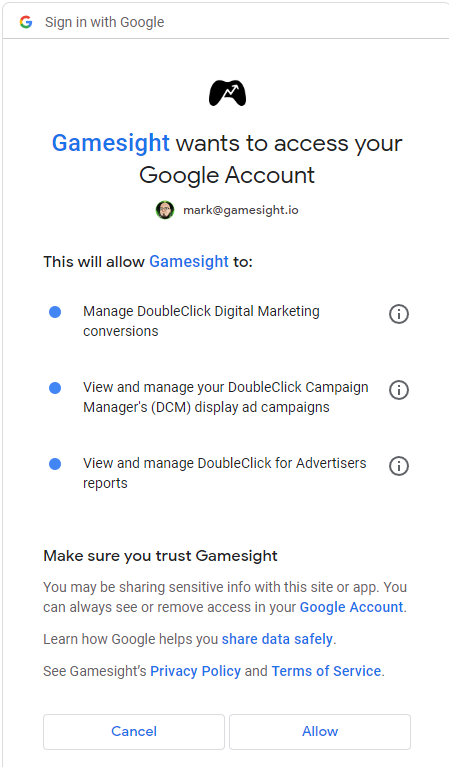Google Campaign Manager
This document covers the steps required to send conversion data from Gamesight Marketing Analytics to Google Campaign Manager (formerly DCM) using "Match ID" for offline conversions.
Postback Integration
This integration is only required to post conversions back from Gamesight to Google Campaign Manager Floodlight Tags.
If you do not require this functionality, you can simply place the Gamesight click tracking link as a click event tag on your DCM ads to track conversions in Gamesight as normal.
1. Create new Floodlights
In order to support the Match ID association process you will need to create 2 separate Floodlights:
- Lead generation / pageview - This is a placeholder floodlight that is used to create the Match ID association between Gamesight and DCM. It is triggered when the user loads the marketing page for your game.
- Offline conversion - This is the floodlight that Gamesight will upload offline conversions to when a user converts.

You can see an overview of the Match ID offline conversion process and how the two Floodlights are used. Note that in this diagram all of the orange steps are handled by Gamesight.

2. Install Web Measurement SDK & Floodlight Tag
Landing Page Required
It is required that users be driven to a landing page that you control to perform the Match ID association if you would like to post conversions to Floodlight Tags. This cannot be accomplished by sending users directly to Steam.
Once the Floodlights are created, the next step is to install the Gamesight Web Measurement SDK on your game's marketing site (or wherever you are driving traffic). The Web Measurement SDK Quick Start provides an overview of this process.
<script>
// Gamesight SDK Snippet
(function(G,m,s,g,h,t){G.gsght=G.gsght||function(){
(G.gsght.q=G.gsght.q||[]).push(arguments)},G.gsght.q=[],G.gsght.h=1*new Date();
h=m.createElement(s),t=m.getElementsByTagName(s)[0];h.async=1;h.src=g;t.parentNode.insertBefore(h,t)
})(window,document,'script','https://cdn.gsght.com/sdk.js');
gsght('init', 'GS-XXXXXX')
</script>
Web SDK API Key
You will need to replace GS-XXXXXX in the above Web SDK snippet with your specific Web SDK API Key. More information on this can be found here.
We additionally need to setup the Match ID association with the user's 'gsid' which can be achieved by including the following snippet on page load.
<script>
gsght('onload', function(){
gtag('config', 'DC-[leadFloodlightConfigID]');
gtag('event', 'conversion', {
'allow_custom_scripts': true,
'send_to': 'DC-[leadFloodlightConfigID]/[activityGroupTagString]/[activityTagString]+[countingMethod]',
'dc_custom_params' : {
'match_id': gsght('get', 'gsid')
}
});
});
</script>
Note that Match IDs are not reportable and cannot be verified through the Google Campaign Manager UI.
3. Create your Google Campaign Manager Tracker
Next you need to create your Google Campaign Manager Tracker in order to link your Google Campaign Manager account to Gamesight so we can upload the offline conversions.
Once you are logged into Gamesight, you can click Trackers (under Acquisition) on the left-hand side of the page to access your tracker management page.
Next, you can search for "Google Campaign Manager" and click on the Google Campaign Manager logo as shown below.
On the next menu, click "Use Google Campaign Manager".
Next, click "Authorize with Google Campaign Manager" and select your Google Campaign Manager account.

You must click "Allow" on the following access prompt shown below.

Now that you have allowed Gamesight access you can select the appropriate "Profile ID" and "Advertiser ID" in Gamesight on the following menu.
With your Profile and Advertiser IDs selected, click "Next".

Take note of the Click URL and Impression URL! They should appear as follows:

Note that the campaign/ad_group/ad parameters are provided in these links by default, but you may use other values.
4. Create Event Tags in Google Campaign Manager
The last step is to create impression and click event tags in Google Campaign Manager. You can find more details on how to set up these tags in Google's documentation.
You should be ready to run your campaign now! You can use the same tacking links for multiple campaigns.
Campaign Manager & Destination URL
The Destination URL shown in Gamesight for your Campaign Manager tracker can be ignored. Your landing page will be set in DCM directly.
Driving Traffic Directly to Storefronts
If you are driving traffic directly to a storefront (Steam, for example) with no landing page - postbacks will not be enabled.
A controlled landing page with the Gamesight Web SDK and your lead-gen/pageview floodlight installed on it is required for posting conversions back to floodlights.
Troubleshooting
| Issue | Resolution |
|---|---|
| The account I am looking for is not showing up in the list after linking my Campaign Manager account. | The account may not have the correct permissions enabled/setup. This CM360 troubleshooting guide may be helpful in checking your account's setup. [CM360 Troubleshooting] |
Updated 4 months ago
